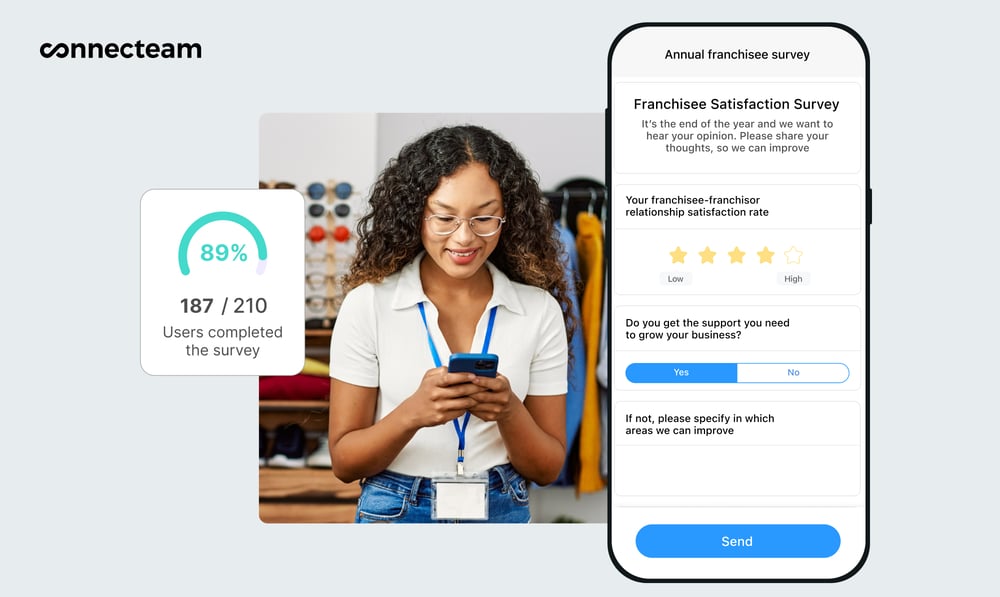Employee benefits surveys help you gather feedback from your workers about the benefits your company offers. In this article, we cover how these surveys can help your business, what questions you should ask, and how Connecteam can support you in creating and sharing your surveys.
Offering meaningful employee benefits is essential to retaining your current employees, attracting new ones, and maintaining your edge in today’s competitive business environment.
But, it can be tough to know what benefits your workers enjoy most. It can also be hard to determine which benefits are simply nice to have and which are absolute must-haves.
That’s where employee benefits surveys can help. These surveys allow employees to voice their thoughts and feelings about workplace benefits.
In this guide, we share everything you need to know about employee benefits surveys, as well as 35 questions you can use to get started.
Key Takeaways
- Employee benefits surveys help managers understand how employees feel about their workplace benefits.
- Running these surveys and acting on the feedback you receive can help improve employees’ work-life balance, boost employee morale, create a culture of honesty, and improve employee health and well-being.
- They can also help reduce employee turnover and increase your bottom line. Plus, you can use the results to benchmark your benefits against other businesses.
- Consider making surveys anonymous to encourage more participation and more honest responses.
- Use Connecteam to run your next employee benefits survey—or any other survey you’d like.
What Are Employee Benefits Surveys?
Employee benefits surveys are questionnaires that gather feedback from employees about the benefits their employer offers.
They aim to give employers insight into workers’ level of satisfaction with current benefits, as well as what they want or need in future benefits. These surveys also measure how much employees are using the benefits provided to them.
They can help you find gaps in employee benefits and compare your business to others in your industry. For example, if other businesses of your size offer their employees access to an Employee Assistance Program (EAP), you might consider offering access to an EAP. Comparing your benefits to those of competitors ensures you stay competitive.
Using the feedback and insights from employee benefits surveys, you can identify areas for improvement and adjust your benefits package accordingly. Conducting these surveys regularly will also make it easier to evolve as your employees’ needs and expectations change.
Why Are Employee Benefits So Important?
Employee benefits are important for many reasons. They can help you:
Attract top talent
Offering a competitive benefits package plays a critical role in attracting top talent. 64% of employees say the benefits package is an important consideration when applying for a new job, while 69% of workers would choose one job over another if it offered better benefits. In other words, a robust benefits package makes your company more appealing to prospective new hires.
Boost satisfaction, engagement, and retention
Providing your employees with meaningful benefits can have a huge impact on their satisfaction, engagement, and loyalty. Benefits like paid time off (PTO), parental leave, flexible work arrangements, and more show employees that you care about them as people. This makes them feel valued and supported, which makes them more connected to your company and their job overall.
In turn, this boosts their job satisfaction and engagement levels. And happy, engaged employees are far less likely to quit.
Did You Know?
On average, it costs about 1.5 times an employee’s annual salary to hire and train their replacement. Discover the true cost of turnover at your company by using Connecteam’s handy employee turnover calculator.
Improve work-life balance
Benefits such as flexible schedules, remote work options, and the option to buy additional PTO allow employees to maintain a healthy work-life balance.
Improve employee health and well-being
Employee benefits like health insurance, wellness programs, EAPs, longer lunch breaks, and PTO all contribute to improving your employees’ physical and mental well-being.
They can help to reduce stress, encourage exercise, and provide access to preventative care. Not only does this show your employees that you value their well-being, but it’s also likely to save you money on paid sick leave.
Increase employee morale and productivity
On a similar note, when employees know that you care about their physical and mental well-being, it leads to better morale across your company. This has a trickle-down effect, as stronger morale creates a positive work environment, and employees are more likely to be productive when their spirits are high and they enjoy coming to work.
In fact, there have been a number of studies linking higher morale with increased productivity. More productive workers means greater efficiency, which means fewer missed deadlines and a higher potential for profit.
How Employee Benefits Surveys Can Help Your Business
There are several reasons you should conduct employee benefits surveys. They can help you:
Reduce employee turnover and cut recruiting costs
These surveys help you understand what employees want from their benefits and how your business can improve its offering. When you can offer your employees a robust, meaningful benefits package, it boosts their satisfaction and makes them less likely to quit.
In fact, research has found that 78% of employees are more likely to stay with their current employer if offered a competitive benefits package.
This reduces employee turnover and eliminates the need to recruit, hire, and train new workers—which can cost a significant amount of money.
This Might Interest You
Read our in-depth guide on how to calculate what it really costs to hire an employee.
Benchmark against other businesses
Employee benefits surveys are a useful way to benchmark your benefits against those offered by competitors. You can see what employees truly value in a benefits package and see if other companies in your industry offer those benefits.
Then, you can use this information to refine your benefits and ensure you maintain a competitive edge.
These surveys also allow you to collect data and insights about your employees’ overall experiences, satisfaction levels, and perceptions of their work environment. By comparing these results with those of other businesses, you can gauge how your organization measures up in terms of employee satisfaction, employee engagement, and other key metrics. This will highlight the areas where your business excels and where it might need a boost.
Improve your bottom line
When you conduct surveys and improve your benefits package, your employees become more engaged, your turnover rate drops, and your business becomes more productive. This can all help improve your bottom line. You’ll miss fewer deadlines, avoid costly mistakes, get more work done, and spend less on hiring replacements for employees who quit.
Elevate Your Benefits Program!
Take your benefits offering to new heights with Connecteam’s employee survey app.
What to Ask In an Employee Benefits Survey
Employee information
You might ask for employees’ names, departments, ID numbers, emails, years of service, or other identifying information if you choose not to make your survey anonymous.
Information about departments can be especially beneficial, as it allows you to evaluate how certain departments and teams feel about specifics of their employee benefit plans. For example, you may find a high portion of the customer support department is dissatisfied with remote working options. Or, maybe a large number of sales team members feel the health insurance allowances aren’t sufficient.
Asking employees to note how long they’ve been with the company can be useful, too. You can determine whether employees with a long tenure feel differently about your company’s benefits than new employees do.
Pro Tip
Use a dedicated employee survey app like Connecteam to easily create, distribute, and analyze your employee benefit satisfaction surveys. Connecteam’s Survey feature gives you immediate insights into your employees’ thoughts and helps you make informed decisions backed by real-time data.
Get started with Connecteam for free today!
Opening questions
Start with 1-3 general questions about your company’s employee benefits package overall. For example:
- Please rate your overall satisfaction with the benefits the company provides.
- 5 – Very satisfied
- 4 – Satisfied
- 3 – Neutral
- 2 – Dissatisfied
- 1 – Very dissatisfied
- Please describe any changes you would like to see in the benefits package.
Closing questions
Similarly, end with 1-2 “final thoughts” questions. These give employees an opportunity to summarize their feelings. For instance: “Is there anything else you would like to share about employee benefits at the company?”
Questions about benefits
Throughout your survey, it’s important to ask a range of questions so you can gather the most comprehensive feedback. Ensure you ask questions about all the types of benefits your company offers—like health insurance, retirement savings, time off, flexible working, and more.
You can also include more targeted questions. For example, say you recently introduced a new vacation and PTO scheme. You might ask employees to rate their overall satisfaction with the scheme and whether they have suggestions to improve it.
Additionally, ensure that your questions gather both quantitative (numerical) and qualitative (non-numerical) data.
Question types for quantitative data
Using a rating scale format helps you collect quantitative data.
For instance, you could use a star ratings system and ask employees to rate each of your company’s benefits. The star ratings might look like:
- ★★★★★ – Excellent
- ★★★★ – Good
- ★★★ – Average
- ★★ – Below average
- ★ – Poor
You can collect all star ratings and divide them by the number of responses to get an average rating. For example, say you have 5 employees and 2 rate a benefit as 3 stars, 2 rate it as 5 stars, and 1 rates it as 2 stars. (3 + 3 + 5 + 5 + 2) / 5 = 3.6 average rating.
You can also use a standard rating scale where employees select an answer with a numerical value. For example, you can ask, “How satisfied are you with the PTO our company offers?” The answer options can be:
- 5 – Very satisfied
- 4 – Satisfied
- 3 – Neutral
- 2 – Dissatisfied
- 1 – Very dissatisfied
Use the same formula above to calculate an average score for each question.
In addition, yes/no questions gather quantitative data. This is because responses are only ever 1 of 2 options, so they’re much easier to quantify—for example, as a percentage.
Imagine that you receive 25 answers to a question asking if employees are satisfied with your company’s health insurance benefits. Say that there were 18 “yes” responses and 7 “no” responses. To calculate the percentage of employees who answered “yes,” divide 18 by 25, then multiply by 100.
(18/25) x 100 = 72%
That means 72% of respondents are satisfied with the health insurance benefits package.
Question types for qualitative data
You can use yes/no questions to gather qualitative data as well. Do this by asking employees to explain their answers. This way, you can calculate a percentage of positive and negative responses and receive insights into why employees answered the way they did.
Additionally, ask open-ended questions where employees can write out a short answer. This gives workers a chance to fully express their feelings and can provide you with valuable information that your team may not have shared with you face-to-face before.
Pro Tip
To analyze data from open-ended questions, try creating a word cloud to highlight common words and feelings. You can then use this data to shape focus groups around key themes and ideas.
35 Employee Benefits Survey Questions
In addition to the intro and outro questions we provided above, below are 35 questions you can use in your own employee benefits surveys. The questions are broken down into 7 categories covering popular employee benefits. Each category has 5 questions.
We recommend keeping surveys no longer than 10-20 questions to make it easy for employees to participate. Mix and match the questions below to create a survey, or use them as inspiration to write your own.
Health insurance
- Are you currently enrolled in the company’s health insurance plan?
- Yes
- No
- How would you rate the company’s health insurance benefits?
- 5 – Excellent
- 4 – Good
- 3 – Average
- 2 – Below average
- 1 – Poor
- Are you satisfied with the overall coverage of the plan? If not, why?
- Yes
- No (please explain) __________
- Is there any additional coverage you’d like in the plan?
- Yes (please specify) __________
- No
- Are there any specific aspects of the health insurance plan that you find lacking?
- Yes (please specify) __________
- No
Time off

- How satisfied are you with the time off benefits offered by the company?
- 5 – Very satisfied
- 4 – Satisfied
- 3 – Neutral
- 2 – Dissatisfied
- 1 – Very dissatisfied
- To what extent do you agree with the following statement? “The company’s time off benefits align well with my personal needs.”
- 5 – Strongly agree
- 4 – Agree
- 3 – Neutral
- 2 – Disagree
- 1 – Strongly disagree
- Are there any additional time off benefits or programs you would like the company to consider? For example, unlimited PTO.
- Yes (please specify) __________
- No
- Are you aware of the policies regarding time off accruals, carryovers, and payouts?
- Yes
- No
- How does our PTO compare to other companies you have worked for?
Flexible working
- Have you used any of the company’s flexible working options?
- Yes
- No
- Are you satisfied with the level of flexibility provided in terms of work location (e.g., remote work, co-working spaces)? If not, why?
- Yes
- No (please explain) __________
- Have you had any problems taking advantage of flexible working arrangements?
- Yes (please specify) __________
- No
- To what extent do you agree with the following statement? “The company’s flexible working options accommodate my work-life balance and personal needs well.”
- 5 – Strongly agree
- 4 – Agree
- 3 – Neutral
- 2 – Disagree
- 1 – Strongly disagree
- Are there any additional flexible working options or programs you would like the company to offer?
- Yes (please specify) __________
- No
Retirement
- Are you currently participating in the company’s retirement savings plan? If not, why?
- Yes
- No (please explain) __________
- To what extent do you agree with the following statement? “I am confident my retirement savings will be enough to support me during my retirement years?”
- 5 – Strongly agree
- 4 – Agree
- 3 – Neutral
- 2 – Disagree
- 1 – Strongly disagree
- Please describe the aspects of the retirement savings plan you find particularly beneficial.
- Are there any specific aspects of the retirement savings plan that you find unsatisfactory?
- Yes (please specify) __________
- No
- Do you feel that the company’s contribution to your retirement savings plan is sufficient? Why or why not?
- Yes (please explain) __________
- No (please explain) __________
Stock options and equity
- To what extent do you agree with the following statement? “I fully understand the terms and conditions of my stock options with the company.”
- 5 – Strongly agree
- 4 – Agree
- 3 – Neutral
- 2 – Disagree
- 1 – Strongly disagree
- Do you feel the stock options are sufficient compared to what other businesses are offering? If not, why?
- Yes
- No (please explain) __________
- Are there any additional training programs you would like the company to offer related to stock options?
- Yes
- No
- Do you use the company’s stock options and equity scheme? If not, why?
- Yes
- No (please explain) __________
- Have you faced any difficulties in accessing the stock options plan?
- Yes (please specify) __________
- No
Childcare options
- How satisfied are you with the childcare options provided by the company?
- 5 – Very satisfied
- 4 – Satisfied
- 3 – Neutral
- 2 – Dissatisfied
- 1 – Very dissatisfied
- Are there any additional childcare benefits you would like the company to offer?
- Yes (please specify) __________
- No
- How do our childcare options compare to other companies you have worked for?
- Are you satisfied with the quality of the childcare providers recommended by the company? If not, why?
- Yes
- No (please explain) __________
- To what extent do you agree with the following statement? “The benefits offered by the company have helped resolve challenges I face regarding childcare arrangements.”
- 5 – Strongly agree
- 4 – Agree
- 3 – Neutral
- 2 – Disagree
- 1 – Strongly disagree
Parental or dependent leave
- Have you taken parental or dependent leave or do you plan to?
- Yes
- No
- Do you think the parental leave offered adequately supports new parents? If not, why?
- Yes
- No (please explain) __________
- How satisfied are you with the length of parental leave offered by the company?
- 5 – Very satisfied
- 4 – Satisfied
- 3 – Neutral
- 2 – Dissatisfied
- 1 – Very dissatisfied
- Are you aware of the flexibility options and phased return-to-work programs offered after parental leave?
- Yes
- No
- How likely are you to recommend the company to a friend or family member based on our parental leave benefit?
- 5 – Very likely
- 4 – Likely
- 3 – Neutral
- 2 – Unlikely
- 1 – Very unlikely
Boost Employee Satisfaction Now!
Discover the secret to happier employees with Connecteam’s benefits survey app.
Start for free
Benefits Survey Template
[Your Business Name] Employee Benefits Survey
[Your Business Name] is committed to providing all employees with the opportunity to share their thoughts about the company’s benefits package to ensure benefits are relevant and meaningful for everyone.
Please fill out the survey below. Your participation is greatly appreciated. Thank you.
__________
Name:
Department:
Date:
- On a scale of 1-5, how satisfied are you with the overall quality of the benefits [Your Business Name] offers employees?
- 5 – Very satisfied
- 4 – Satisfied
- 3 – Neutral
- 2 – Dissatisfied
- 1 – Very dissatisfied
Health insurance benefits
- Are you currently enrolled in [Your Business Name] ’s health insurance plan?
- Yes
- No
- If you answered “yes” to question 2, how would you rate the benefits plan’s coverage?
- 5 – Excellent
- 4 – Good
- 3 – Average
- 2 – Below average
- 1 – Poor
Flexible working benefits
- To what extent do you agree with the following statement? “[Your Business Name] ’s flexible working options accommodate my work-life balance and personal needs well.”
- 5 – Strongly agree
- 4 – Agree
- 3 – Neutral
- 2 – Disagree
- 1 – Strongly disagree
- Are there any additional flexible working options or programs you would like [Your Business Name] to offer?
- Yes (please specify) __________
- No
Time off benefits
- How satisfied are you with the time off benefits offered by [Your Business Name] ?
- 5 – Very satisfied
- 4 – Satisfied
- 3 – Neutral
- 2 – Dissatisfied
- 1 – Very dissatisfied
- Are there any additional time off benefits you would like [Your Business Name] to implement?
- Yes (please specify) __________
- No
8. Do you have any further opinions you’d like to share regarding the employee benefits [Your Business Name] offers? (Optional)
9. If [Your Business Name] were to implement a new employee benefit, what would you like to see? (Optional)
Use Connecteam to Create Your Next Survey
While you can create a paper-based survey or a digital one using a spreadsheet or word processor, you’ll still need to manually collect and analyze employee responses. This will slow down your process and take time away from other pressing tasks.
That’s why we recommend using Connecteam, an all-in-one employee management platform with dedicated tools for creating and conducting surveys.
Start with a template, or create a new survey from the ground up using various question formats. Connecteam supports yes/no, multiple-choice, rating scale, and open-ended questions—perfect for collecting quantitative and qualitative data.

Create surveys right from your mobile device and share them with your team instantly. Connecteam will notify workers when they have a new survey to complete—which they can do from their mobile devices, too. You’re also able to send push notifications to employees reminding them to complete surveys.
Plus, you receive results in real time and quickly see how many employees have completed the survey.
For even more immediate employee feedback on specific topics, you can create and publish live digital polls as well.
Conclusion
Employee benefits surveys are a great way to understand what your employees think and feel about the benefits your company offers. You can ask questions about health insurance, retirement, stock options and equity, childcare options, different types of leave, PTO, flexible working arrangements, and more. This way, you can adjust your offerings to suit your workers’ exact needs and preferences.
It can take time and effort to create a benefits survey, so we recommend using Connecteam. It’s an all-in-one solution perfect for creating and publishing surveys in minutes. The platform also makes it simple to analyze survey results so you can determine areas for improvement and make meaningful changes to your benefits package.
FAQs
What are the top 3 most sought-after employee benefits?
Generous health insurance, retirement plans, and flexible working options are generally considered to be the most sought-after employee benefits.
How do you find out what benefits your employees want?
Employee surveys are a great way to find out what benefits your workers want. However, you could also try holding employee focus groups, conducting one-on-one interviews, or analyzing employee exit interviews.




